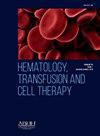Clinical efficacy and safety of flumatinib versus dasatinib combined with multi-drug chemotherapy in adults with Philadelphia-positive acute lymphoblastic leukemia
IF 1.8
Q3 HEMATOLOGY
引用次数: 0
Abstract
Introduction: Flumatinib, a highly selective ABL kinase inhibitor, exhibits stronger inhibition of intracellular BCR-ABL tyrosine kinase activity, compared to Imatinib. However, there is limited research comparing the real-world efficacy and safety of flumatinib and dasatinib in patients with Philadelphia-positive acute lymphoblastic leukemia (Ph+ ALL). Objective: Investigating the differences in therapeutic efficacy and safety between flumatinib and dasatinib in combination with multi-drug chemotherapy for the treatment of newly diagnosed Ph+ ALL. Method: In this study, we assessed 43 patients with newly diagnosed Ph+ ALL (20 in the flumatinib group, 23 in the dasatinib group). Results: There were no significant differences in gender, age, fusion gene type, initial blood routine, bone marrow blast cell ratio or chromosome karyotype between the two groups. Within 1 month, there were no significant differences in the complete response (CR), major molecular response (MMR) or minimal residual disease (MRD) negativity rate between the flumatinib and dasatinib groups. Similarly, within 3 months, there were no significant differences in CR or MMR rates between the two groups. However, the rates of complete molecular response (CMR) and MRD negativity within 3 months were significantly higher in the flumatinib group, compared to the dasatinib group (P < 0.05). Additionally, the flumatinib group exhibited fewer adverse reactions compared to the dasatinib group. Conclusion: These findings suggest that flumatinib is a safe and effective tyrosine kinase inhibitor (TKI) for achieving CMR and MRD negativity in patients with Ph+ ALL, as supported by this small series of patients.
费城阳性急性淋巴细胞白血病成人患者服用氟马替尼与达沙替尼联合多种药物化疗的临床疗效和安全性。
简介氟马替尼是一种高选择性ABL激酶抑制剂,与伊马替尼相比,它对细胞内BCR-ABL酪氨酸激酶活性的抑制作用更强。然而,在费城阳性急性淋巴细胞白血病(Ph+ ALL)患者中,对氟马替尼和达沙替尼的实际疗效和安全性进行比较的研究十分有限:调查氟马替尼和达沙替尼联合多种药物化疗治疗新诊断的Ph+ ALL的疗效和安全性差异:在这项研究中,我们评估了43例新诊断的Ph+ ALL患者(氟马替尼组20例,达沙替尼组23例):结果:两组患者在性别、年龄、融合基因类型、初始血常规、骨髓造血细胞比率和染色体核型方面无明显差异。1个月内,氟马替尼组和达沙替尼组的完全应答率(CR)、主要分子应答率(MMR)和最小残留病(MRD)阴性率无明显差异。同样,在3个月内,两组的CR或MMR率也无明显差异。然而,与达沙替尼组相比,氟马替尼组在3个月内的完全分子反应(CMR)率和MRD阴性率明显更高(P < 0.05)。此外,与达沙替尼组相比,氟马替尼组的不良反应更少:结论:这些研究结果表明,氟马替尼是一种安全有效的酪氨酸激酶抑制剂(TKI),可使Ph+ ALL患者获得CMR和MRD阴性,这一点也得到了该小样本患者的支持。
本文章由计算机程序翻译,如有差异,请以英文原文为准。
求助全文
约1分钟内获得全文
求助全文
来源期刊

Hematology, Transfusion and Cell Therapy
Multiple-
CiteScore
2.40
自引率
4.80%
发文量
1419
审稿时长
30 weeks
 求助内容:
求助内容: 应助结果提醒方式:
应助结果提醒方式:


